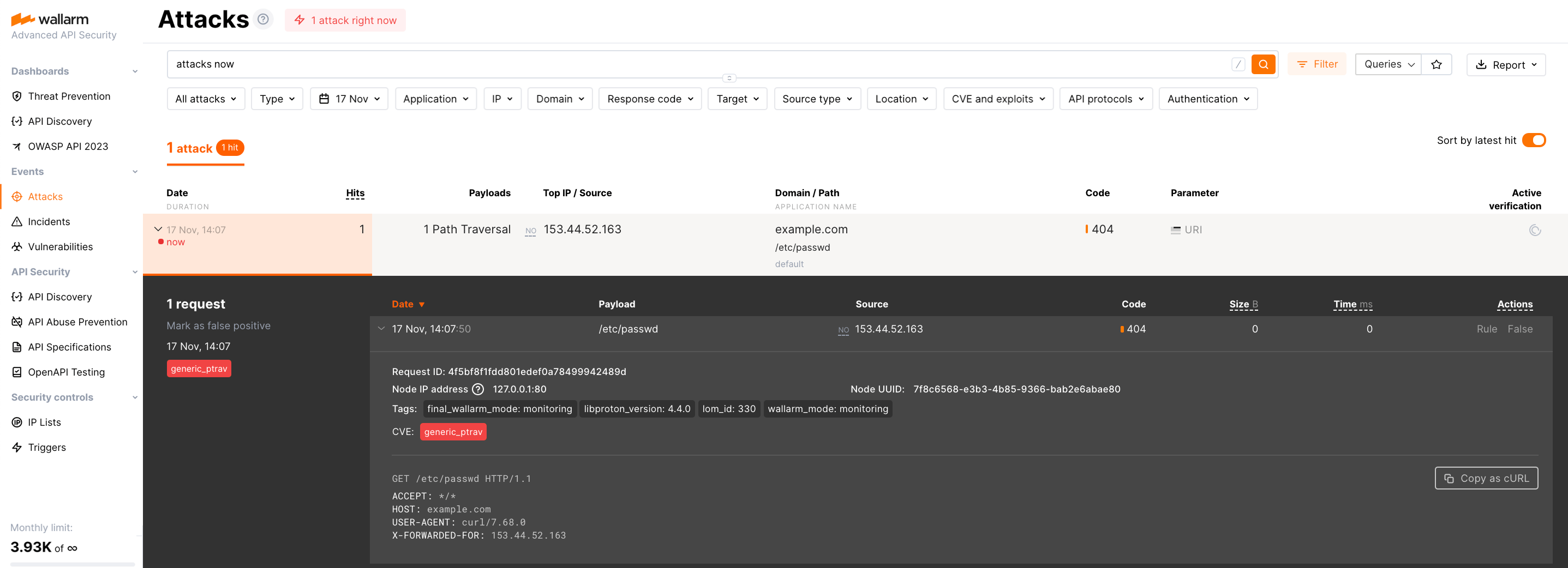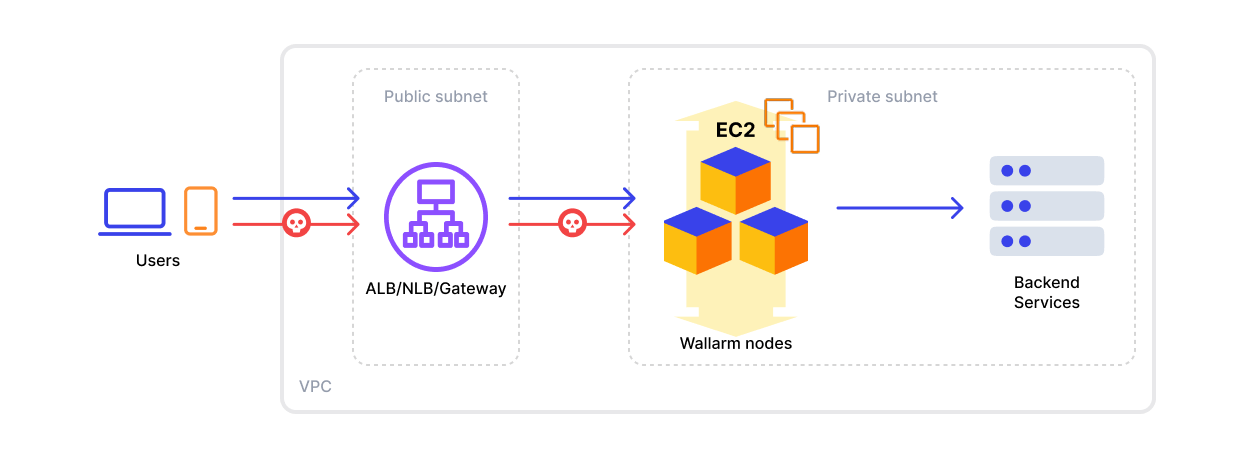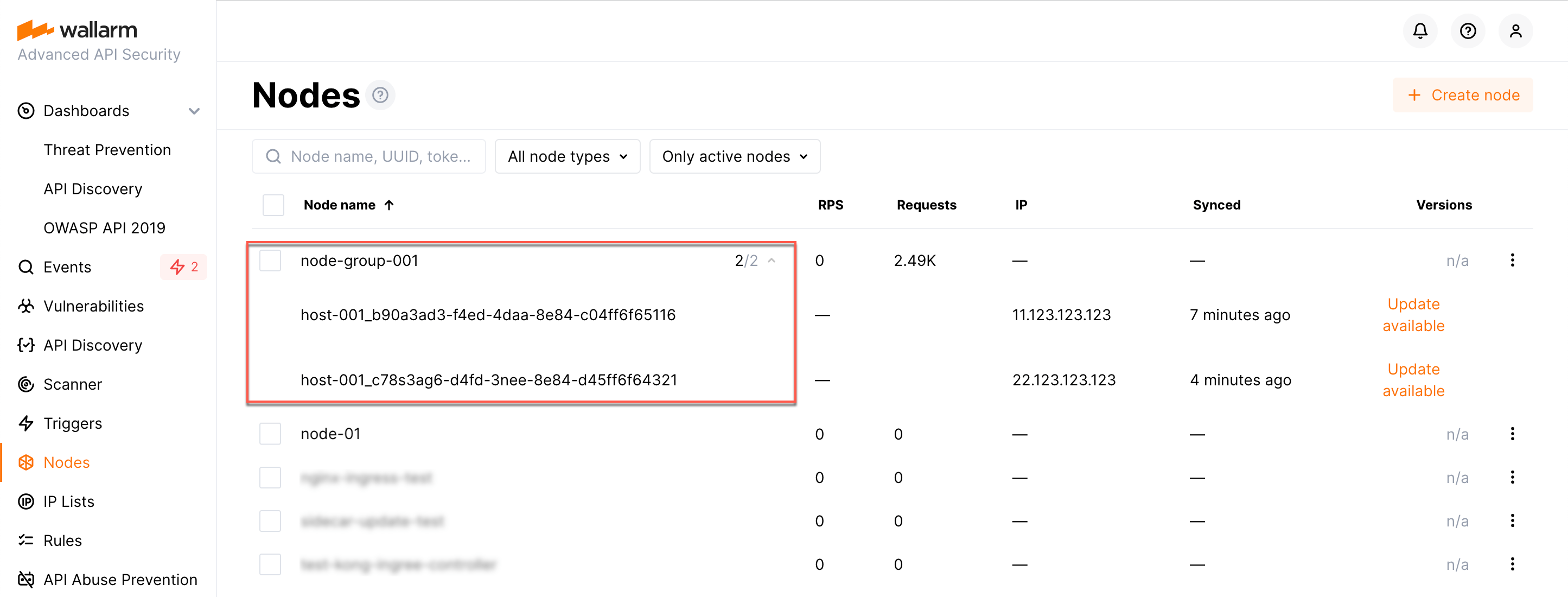Deploying Wallarm from Amazon Machine Image¶
This article provides instructions for deploying Wallarm on AWS in-line using the official Amazon Machine Image (AMI).
The image is based on Debian and the NGINX version provided by Debian. Currently, the latest image uses Debian 12, which includes NGINX stable 1.22.1.
Deploying the Wallarm Node from the AMI on AWS typically takes around 10 minutes.
Security note
This solution is designed to follow AWS security best practices. We recommend avoiding the use of the AWS root account for deployment. Instead, use IAM users or roles with only the necessary permissions.
The deployment process assumes the principle of least privilege, granting only the minimal access required to provision and operate Wallarm components.
For guidance on estimating AWS infrastructure costs for this deployment, see the Cost Guidance for Deploying Wallarm in AWS page.
Use cases¶
Among all supported Wallarm deployment options, AMI is recommended for Wallarm deployment in these use cases:
-
Your existing infrastructure resides on AWS.
-
You aim to deploy a security solution as a separate cloud instance, rather than installing it directly on frontend systems like NGINX.
Requirements¶
-
An AWS account
-
Understanding of AWS EC2, Security Groups
-
Any AWS region of your choice, there are no specific restrictions on the region for the Wallarm node deployment
Wallarm supports both single availability zone (AZ) and multi availability zone deployments. In multi-AZ setups, Wallarm Nodes can be launched in separate availability zones and placed behind a Load Balancer for high availability.
-
Access to the account with the Administrator role in Wallarm Console for the US Cloud or EU Cloud
-
Access to
https://us1.api.wallarm.com:444for working with US Wallarm Cloud or tohttps://api.wallarm.com:444for working with EU Wallarm Cloud. If access can be configured only via the proxy server, then use the instructions -
Access to the IP addresses below for downloading updates to attack detection rules and API specifications, as well as retrieving precise IPs for your allowlisted, denylisted, or graylisted countries, regions, or data centers
-
Executing all commands on a Wallarm instance as a superuser (e.g.
root)
1. Create a pair of SSH keys in AWS¶
During the deploying process, you will need to connect to the virtual machine via SSH. Amazon EC2 allows creating a named pair of public and private SSH keys that can be used to connect to the instance.
To create a key pair:
-
Navigate to the Key pairs tab on the Amazon EC2 dashboard.
-
Click the Create Key Pair button.
-
Enter a key pair name and click the Create button.
A private SSH key in PEM format will automatically start to download. Save the key to connect to the created instance in the future.
To see detailed information about creating SSH keys, proceed to the AWS documentation.
2. Create a Security Group¶
A Security Group defines allowed and forbidden incoming and outgoing connections for virtual machines. The final list of connections depends on the protected application (e.g., allowing all of the incoming connections to the TCP/80 and TCP/443 ports).
The Wallarm AMI is designed to operate with a minimal set of permissions. When deploying the instance, we recommend assigning an IAM role and configuring security groups based on the principle of least privilege, granting only the access required for the node's operation to align with AWS security best practices.
To create a security group for the filtering node:
-
Navigate to the Security Groups tab on the Amazon EC2 dashboard and click the Create Security Group button.
-
Enter a security group name and an optional description into the dialog window that appears.
-
Select the required VPC.
-
Configure incoming and outgoing connections rules on the Inbound and Outbound tabs.
-
Click the Create button to create the security group.
Rules for outgoing connections from the security group
When creating a security group, all of the outgoing connections are allowed by default. If you restrict outgoing connections from the filtering node, make sure that it is granted access to a Wallarm API server. The choice of a Wallarm API server depends on the Wallarm Cloud you are using:
- If you are using the US Cloud, your node needs to be granted access to
us1.api.wallarm.com. - If you are using the EU Cloud, your node needs to be granted access to
api.wallarm.com.
The filtering node requires access to a Wallarm API server for proper operation.
To see detailed information about creating a security group, proceed to the AWS documentation.
3. Launch a Wallarm node instance¶
To launch an instance with the Wallarm filtering node, proceed to this link and subscribe to the filtering node.
When creating an instance, you need to specify the previously created security group as follows:
-
While working with the Launch Instance Wizard, proceed to the 6. Configure Security Group instance launch step by clicking the corresponding tab.
-
Choose the Select an existing security group option in the Assign a security group setting.
-
Select the security group from the list that appears.
After specifying all of the required instance settings, click the Review and Launch button, make sure that instance is configured correctly, and click the Launch button.
In the window that appears, specify the previously created key pair by performing the following actions:
-
In the first drop-down list, select the Choose an existing key pair option.
-
In the second drop-down list, select the name of the key pair.
-
Make sure you have access to the private key in PEM format from the key pair you specified in the second drop-down list and tick the checkbox to confirm this.
-
Click the Launch Instances button.
The instance will launch with the preinstalled filtering node.
To see detailed information about launching instances in AWS, proceed to the AWS documentation.
4. Connect to the filtering node instance via SSH¶
To see detailed information about ways to connect to an instance via SSH, proceed to the AWS documentation.
You need to use the admin username to connect to the instance.
Using the key to connect via SSH
Use the private key in PEM format that you created earlier to connect to the instance via SSH. This must be the private key from the SSH key pair that you specified when creating an instance.
5. Generate a token to connect an instance to the Wallarm Cloud¶
The local Wallarm filtering node needs to connect with the Wallarm Cloud using a Wallarm token of the appropriate type. An API token allows you to create a node group in the Wallarm Console UI, which helps in organizing your node instances effectively.
Generate a token as follows:
6. Connect the instance to the Wallarm Cloud¶
The cloud instance's node connects to the Cloud via the cloud-init.py script. This script registers the node with the Wallarm Cloud using a provided token, globally sets it to the monitoring mode, and sets up the node to forward legitimate traffic based on the --proxy-pass flag. Restarting NGINX finalizes the setup.
Run the cloud-init.py script on the instance created from the cloud image as follows:
-
WALLARM_LABELS='group=<GROUP>'sets a node group name (existing, or, if does not exist, it will be created). It is only applied if using an API token. -
<TOKEN>is the copied value of the token. -
<PROXY_ADDRESS>is an address for Wallarm node to proxy legitimate traffic to. It can be an IP of an application instance, load balancer, or DNS name, etc., depending on your architecture.
7. Configure sending traffic to the Wallarm instance¶
Update targets of your load balancer to send traffic to the Wallarm instance. For details, please refer to the documentation on your load balancer.
8. Test the Wallarm operation¶
-
The request with test Path Traversal attack to an address of either the load balancer or the machine with the Wallarm node:
-
Open Wallarm Console → Attacks section in the US Cloud or EU Cloud and make sure the attack is displayed in the list.

Since Wallarm operates in the monitoring mode, the Wallarm node does not block the attack but registers it.
-
Optionally, test other aspects of the node functioning.
9. Fine-tune the deployed solution¶
The deployment is now complete. The filtering node may require some additional configuration after deployment.
Wallarm settings are defined using the NGINX directives or the Wallarm Console UI. Directives should be set in the following files on the Wallarm instance:
-
/etc/nginx/sites-enabled/defaultdefines the configuration of NGINX -
/etc/nginx/conf.d/wallarm.confdefines the global configuration of Wallarm filtering node -
/etc/nginx/conf.d/wallarm-status.confdefines the filtering node monitoring service configuration -
/opt/wallarm/wstore/wstore.yamlwith the postanalytics service (wstore) settings
You can modify the listed files or create your own configuration files to define the operation of NGINX and Wallarm. It is recommended to create a separate configuration file with the server block for each group of the domains that should be processed in the same way (e.g. example.com.conf). To see detailed information about working with NGINX configuration files, proceed to the official NGINX documentation.
Creating a configuration file
When creating a custom configuration file, make sure that NGINX listens to the incoming connections on the free port.
Below there are a few of the typical settings that you can apply if needed:
To apply the settings, restart NGINX on the Wallarm instance:
Each configuration file change requires NGINX to be restarted to apply it.


